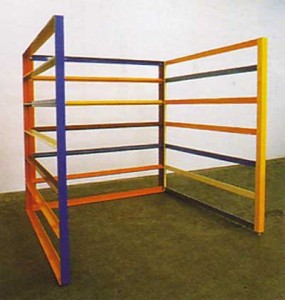For ‘Flash Art’ magazine
Liam Gillick offered a new take on glitzy art openings by washing the floor of Casey Kaplan’s gallery with cheap vodka and covering it with black glitter. Visitors tracked the sparkly stuff into the main space, where a row of aluminum corrals as colorful as jungle gyms faced a line of black text on the wall opposite. Arranged in a broken Greek key pattern and missing the usual colored Plexiglas panels, Gillick’s architectural sculptures tempted viewers to interact with them. On the wall, a repeated text reading, ‘sit now on a ridge,’ referred to a journey described in the artist’s recent book, ‘Literally No Place’ (a translation of the word utopia), which in turn was inspired by behavioral scientist B.F. Skinner’s proposals to alter human behavior through environmental stimuli.
Without reading Gillick’s book, which was not part of the exhibition, it was next to impossible to understand what was taking place, particularly with the unnecessary glitter and vodka element. The show was elegant but so highly conceptual that viewers who bought the book instead of the art came out ahead. Gillick’s signature retro-chic sculptures are meant to provoke discussion about how the built environment effects human thought and behavior, but it’s only in his writing that these complex investigations into social science are developed. Structured as a series of proposals for fictional stories, the book forces the issue of how space is constructed, and it’s here that the audience is taken ‘literally some place.’